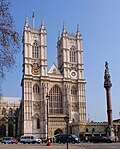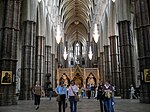Poets' Corner

Poets' Corner is the name traditionally given to a section of the South Transept of Westminster Abbey in the City of Westminster, London because of the high number of poets, playwrights, and writers buried and commemorated there. The first poet interred in Poets' Corner was Geoffrey Chaucer in 1400. Over a century after his death, William Shakespeare was commemorated with a monument in 1740. Over the centuries, a tradition has grown up of interring or memorialising people there in recognition of their contribution to British culture. In the overwhelming majority of cases, the honour is awarded to writers. In 2009, the founders of the Royal Ballet were commemorated in a memorial floor stone and on 25 September 2010, the writer Elizabeth Gaskell was celebrated with the dedication of a panel in the memorial window. On 6 December 2011, former Poet Laureate Ted Hughes was commemorated with a floor stone. On 22 November 2013, the fiftieth anniversary of his death, writer C. S. Lewis was commemorated with a memorial floor stone. The poet Philip Larkin was commemorated with a floor stone dedicated on 2 December 2016.
Excerpt from the Wikipedia article Poets' Corner (License: CC BY-SA 3.0, Authors, Images).Poets' Corner
Dean's Yard, London Millbank
Geographical coordinates (GPS) Address Website Nearby Places Show on map
Geographical coordinates (GPS)
| Latitude | Longitude |
|---|---|
| N 51.499166666667 ° | E -0.12736111111111 ° |
Address
Westminster Abbey
Dean's Yard 20
SW1P 3PA London, Millbank
England, United Kingdom
Open on Google Maps








